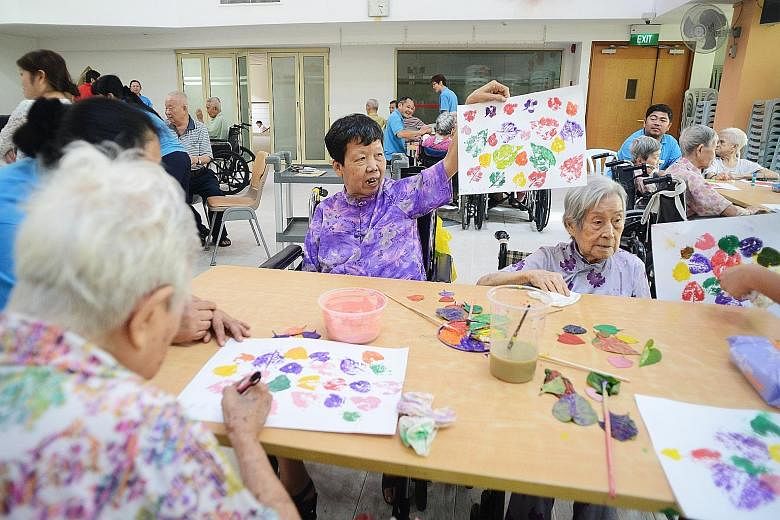Amid the hustle and bustle at a daycare centre, a group of seven elderly folk sat at a table, diligently glueing bits of coloured paper onto the printed outline of a fish.
After adding the finishing touches of glitter and sequins to the "rainbow fish", Ms Lim Soong Hiang, 62, lamented: "Aiyah, mine isn't so nice. I wasn't concentrating."
She was not the only one at the AWWA Rehab and Day Care Centre taking the art project seriously. The others were equally focused on their task when Mind & Body visited the centre in Ang Mo Kio recently.
To them, it was not just something to while away the time, but a part of their rehabilitation. "It keeps our fingers flexible and our minds active," said Ms Lim, who suffers from numbness in her hands.
Such "visual arts" sessions are held under the Wellness Programme started by the Agency For Integrated Care (AIC) last year. It aims to improve the participants' well-being and quality of life.
While it began as small-scale pilots in February last year, the programme is now a full-fledged one.
It is based on structured curricula developed by professionals in the arts scene, and adapted for the elderly. It is the first of its kind in the community care sector to be rolled out on a nationwide scale.
The Wellness Programme now comprises two initiatives - visual arts and creative movement. They are co-funded by the National Arts Council (NAC). The visual arts initiative involves painting and printing, such as with sponges. One can also use low-cost materials such as rice grains, coloured paper and plastic bottles to create artwork.
The creative movement initiative integrates everyday actions into movements that can promote mobility, while enhancing interaction and imagination. For example, one may be asked to mimic the peeling of an orange with one's hands, and this action is extrapolated into an exercise.
Both types of activities can be done even if one is confined to a wheelchair or has limited mobility.
Those who want to facilitate these activities have to go for training - 12 hours for visual arts and 14 hours for creative movement. As of April, 99 staff from 26 community care organisations have been trained in visual arts sessions, while 55 from 19 organisations have been trained to run creative movement activities, AIC said. These include nursing homes, day rehabilitation centres and community hospitals.
At the Ling Kwang Home for Senior Citizens, the visual arts sessions have been well received by clients.
The participation rate has been high - between 82 per cent and 96 per cent over a period of nine months. The activity is held once a month. Seven in 10 said they are "happy" when doing the activity, while 13 per cent rated themselves as being "very happy".
These findings came from a study of 45 clients aged 57 to 97 years old.
Ms Bernadette Arguilla, a physiotherapist at Ling Kwang Home, said the use of unconventional materials, such as leaves, sponges and eggshells, gives participants more leeway to express their feelings.
"It gets them to think about the past and present, and to express it," she said. "Previously, we just gave them something to paint or colour which can come across as childish."
What sets the activity apart from basic colouring or tracing is the detail and thought required, said Mr Seetharaman Prabakaran, a senior occupational therapist who runs the visual arts sessions at AWWA Rehab & Day Care Centre.
"Sometimes, an artwork takes a few days to complete. Some people will continue working on it during their free time - it needs more patience and commitment," he said.
Several pieces have also been submitted for public exhibitions, such as one by Ms Juan Po Giok, who used buttons to form a tree. The 65- year-old's artwork was displayed at the National Library Building last year for the Silver Arts exhibition organised by the NAC. "I was shocked," she joked. "I didn't think it was anything special."
Other gains noted by staff are improvements in fine motor skills and self-esteem, said Mr Sairam Azad, assistant director of health and senior care at AWWA.
Still, it can be tricky to get the elderly to try new things. Language issues can pose a hurdle, said Ms Jumir Cansino, a therapy aide at Villa Francis Home for the Aged, which started running creative movement sessions in February last year. Facilitators speak mostly in English, which some seniors do not understand well. "We use body language to explain and show them the actions. We also do the moves with them, so they won't feel shy," said Ms Cansino.
The organisations interviewed said they intend to continue running the programme. Villa Francis, for instance, hopes to send even more staff for training.
Said Mr Dennis Tan, chief executive of Ling Kwang Home: "As long as they continue to enjoy the activity, we are likely to carry on."
Indeed, for all the tangible benefits, the bottom line is that these activities add joy to the seniors' lives.
Ms Juan has attended several visual arts sessions at Ling Kwang Home as she likes working with her hands, partly due to her past profession as a seamstress. "It makes me happy," she said. "As long as it's not too challenging, I'm game."


